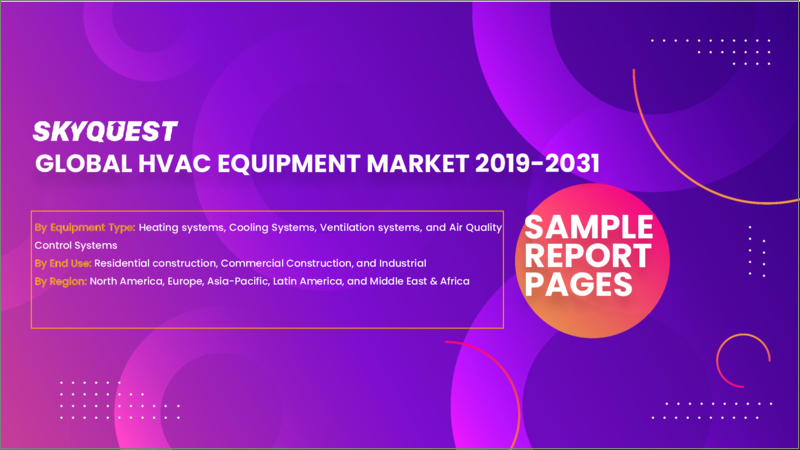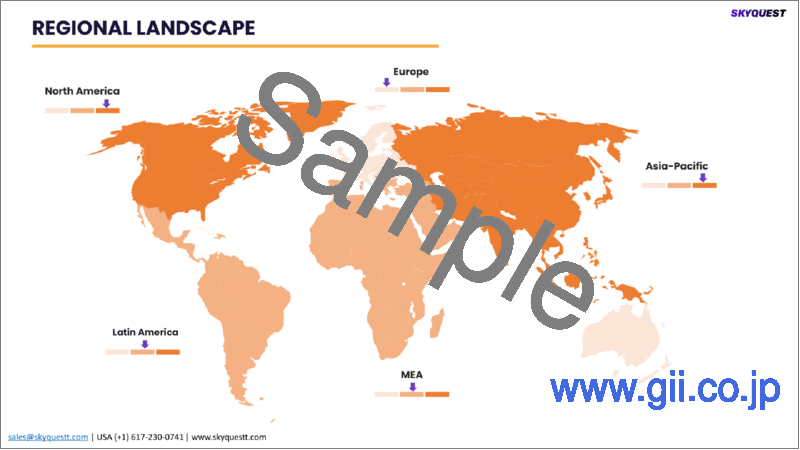|
|
市場調査レポート
商品コード
1427254
HVAC機器の世界市場規模、シェア、成長分析、機器タイプ別、エンドユーザー別、用途別- 産業別予測2023-2030年Global HVAC Equipment Market Size, Share, Growth Analysis, By Equipment type(Heating systems, cooling systems), By End user(Residential construction, commercial construction), By Application(Residential, commercial) - Industry Forecast 2023-2030 |
||||||
| HVAC機器の世界市場規模、シェア、成長分析、機器タイプ別、エンドユーザー別、用途別- 産業別予測2023-2030年 |
|
出版日: 2024年02月08日
発行: SkyQuest
ページ情報: 英文 157 Pages
納期: 3~5営業日
|
- 全表示
- 概要
- 目次
HVAC機器の世界市場規模は、2022年に1,383億2,000万米ドルと評価され、予測期間(2024-2031年)のCAGRは6.40%で、2023年の1,471億7,000万米ドルから2031年には2,417億5,000万米ドルに成長する見通しです。
世界のHVAC機器市場は、多様な産業や住宅スペースの暖房、換気、空調のニーズに応える、繁栄し不可欠な分野です。新興国を中心に建設活動が活発化し、新築住宅や商業ビルにおけるHVACシステムの需要が高まっています。エネルギー効率の高いソリューションに対する意識の高まりと二酸化炭素排出量の削減が、エネルギー効率の高いHVAC機器の採用を後押ししています。さらに、都市化、気候条件の変化、生活水準の向上といった要因も市場拡大に寄与しています。しかし、特に高度なシステムにおいては、高い設置費用とメンテナンス費用が市場成長の障害となる可能性があります。複雑な規制状況や地域によって異なるエネルギー効率基準は、メーカーにとっても消費者にとっても課題となります。さらに、COVID-19の大流行は、サプライチェーンや建設活動の混乱により一時的に市場に影響を与えています。HVAC機器市場の主な動向には、自動化、エネルギー管理、遠隔監視を強化するためのスマート技術とモノのインターネット(IoT)の統合が含まれます。また、HVACシステムが環境に与える影響を軽減するため、持続可能な冷媒や環境に優しいソリューションへのシフトも見られます。さらに、呼吸器系の健康やアレルギーに対する懸念から、高度なろ過システムや空気清浄機による室内空気の質の向上が重視されるようになっています。こうした課題や動向の中、HVAC機器市場にはいくつかのビジネスチャンスが存在します。既存のHVACシステムをエネルギー効率の高いスマート・ソリューションで改修する需要の増加は、大きな市場機会を示しています。特に発展途上国における建設産業の急速な拡大は、HVAC機器メーカーに計り知れない可能性をもたらしています。さらに、環境に優しい建物や持続可能なインフラに対する需要の高まりが、環境に優しいHVACソリューションの必要性を後押ししています。
世界のHVAC機器市場の規模を推定・検証し、その他依存する様々なサブマーケットの規模を推定するために、トップダウンアプローチとボトムアップアプローチを用いました。市場規模を推計するために使用した調査手法には、以下の詳細が含まれる:2次調査を通じて市場の主要企業を特定し、1次調査と2次調査を通じて各地域における市場シェアを決定しました。この全手順には、主要企業の年次報告書および財務報告書の調査、CEO、副社長、取締役、マーケティング担当役員などの業界リーダーからの重要な洞察を得るための広範なインタビューが含まれます。シェアの割合や内訳はすべて二次情報を用いて決定し、一次情報によって検証しました。本調査でカバーする市場に影響を与える可能性のあるすべてのパラメータを考慮し、詳細に調査し、一次調査を通じて検証し、最終的な量的・質的データを得るために分析しました。
世界のHVAC機器市場のセグメント分析
世界のHVAC機器市場は、機器タイプ、エンドユーザー、用途、地域に基づいてセグメント化されます。機器タイプ別では、市場は暖房システム、冷房システム、換気システム、空気品質制御システムに区分されます。エンドユーザー別では、市場は住宅建設、商業建設、ヘルスケア、ホスピタリティ、小売、製造、その他に区分されます。用途別では、住宅用、商業用、工業用に区分されます。地域別では北米、欧州、アジア太平洋、中東・アフリカ、ラテンアメリカに区分されます。
世界のHVAC機器市場の促進要因
エネルギー効率に対する意識の高まりと重視により、最適な快適性を確保しながらエネルギー消費を最小限に抑えることができるHVAC機器に対する需要が生じています。エネルギー効率の高いシステムは、運用コストと環境への影響を削減する上で重要な役割を果たしています。顕著な例として、インバーターベースの空調システムの採用が挙げられます。このシステムでは、コンプレッサーの回転数が冷却要件に応じて調整されるため、エネルギー効率が大幅に改善し、電力消費量が削減されます。
世界のHVAC機器市場における抑制要因
HVAC機器市場は、温室効果ガスの排出を緩和し、環境に優しい冷媒の使用を奨励するための厳格な環境規制の影響下にあります。こうした規制の遵守はメーカーにとって課題であり、適合製品を開発し市場に投入するための研究開発に多額の投資が必要となる可能性があります。一例として、ハイドロクロロフルオロカーボン(HCFC)のようなオゾン層を破壊する冷媒の段階的廃止は、ハイドロフルオロカーボン(HFC)や自然冷媒を含む、より環境に優しい代替物の採用につながった。
世界のHVAC機器市場の動向
スマートテクノロジーとモノのインターネット(IoT)の導入が、HVAC業界に変革をもたらしつつあります。HVACシステムは現在、遠隔操作や監視が可能になり、エネルギーの最適化、予知保全、パーソナライズされた快適性設定が容易になっています。例えば、スマート・サーモスタットのイントロダクションより、ユーザーはモバイル・アプリケーションを通じて温度設定を管理できるようになった。これらの機器には、ユーザーの好みを学習し、エネルギー効率を高めるためにHVACシステムを自動的に調整する機能もあります。
目次
- エグゼクティブサマリー
- 調査手法
- 親市場の分析
- 主な市場の考察
- 技術分析
- 価格分析
- サプライチェーン分析
- バリューチェーン分析
- 市場のエコシステム
- IP分析
- 貿易分析
- スタートアップ分析
- 原材料の分析
- イノベーションマトリクス
- パイプライン製品の分析
- マクロ経済指標
- 主な投資の分析
- 主な成功要因
- 競合の程度
- 市場力学と見通し
- 市場力学
- 促進要因
- 機会
- 抑制要因
- 課題
- 規制情勢
- ポーターの分析
- 将来の混乱についての特別な考察
- 市場力学
- HVAC機器の世界市場:機器タイプ別
- 市場概要
- 暖房システム
- 冷却システム
- 換気システム
- 空気品質管理システム
- HVAC機器の世界市場:エンドユーザー別
- 市場概要
- 住宅建設
- 商業建設
- ヘルスケア
- ホスピタリティ
- 小売り
- 製造業
- その他
- HVAC機器の世界市場:用途別
- 市場概要
- 住宅
- 商業
- 産業
- HVAC機器の世界市場規模:地域別
- 市場概要
- 北米
- 米国
- カナダ
- 欧州
- ドイツ
- スペイン
- フランス
- 英国
- その他欧州地域
- アジア太平洋
- 中国
- インド
- 日本
- 韓国
- その他アジア太平洋地域
- ラテンアメリカ
- ブラジル
- その他ラテンアメリカ地域
- 中東・アフリカ(MEA)
- GCC諸国
- 南アフリカ
- その他中東・アフリカ地域
- 競合情勢
- 上位5社の比較
- 主要企業の市場ポジショニング(2021年)
- 主な市場企業が採用した戦略
- 主要成功戦略
- 市場における最近の活動
- 主要企業の市場シェア(2021年)
- 主要企業プロファイル
- Daikin Industries(Japan)
- Johnson Controls(US)
- Mitsubishi Electric Corporation(Japan)
- Carrier Global Corporation(US)
- LG Electronics Inc.(South Korea)
- Trane Technologies plc(Ireland)
- Lennox International Inc.(US)
- Fujitsu General Ltd.(Japan)
- Rheem Manufacturing Company(US)
- Samsung Electronics Co., Ltd.(South Korea)
- Haier Group Corporation(China)
- Panasonic Corporation(Japan)
- Hitachi, Ltd.(Japan)
- Ingersoll Rand Inc.(Ireland)
- Nortek Global HVAC LLC(US)
- Zamil Air Conditioners Holding Co. Ltd.(Saudi Arabia)
- Gree Electric Appliances Inc.(China)
- Midea Group Co., Ltd.(China)
- Vaillant Group(Germany)
- Viessmann Group(Germany)
Global HVAC Equipment Market size was valued at USD 138.32 Billion in 2022 and is poised to grow from USD 147.17 Billion in 2023 to USD 241.75 Billion by 2031, at a CAGR of 6.40% during the forecast period (2024-2031).
The Global HVAC Equipment Market is a thriving and indispensable sector catering to the heating, ventilation, and air conditioning needs of diverse industries and residential spaces. The escalating construction activities, particularly in emerging economies, fuel the demand for HVAC systems in new residential and commercial buildings. The increasing awareness of energy-efficient solutions and the imperative to reduce carbon emissions drive the adoption of energy-efficient HVAC equipment. Additionally, factors like urbanization, changing climatic conditions, and improving living standards contribute to the expansion of the market. However, high installation and maintenance costs, especially for advanced systems, can serve as obstacles to market growth. The complex regulatory landscape and varying energy efficiency standards across different regions pose challenges for manufacturers and consumers alike. Furthermore, the COVID-19 pandemic has temporarily impacted the market due to disruptions in supply chains and construction activities. Key trends in the HVAC equipment market include the integration of smart technologies and the Internet of Things (IoT) for enhanced automation, energy management, and remote monitoring. The market is also witnessing a shift towards sustainable refrigerants and eco-friendly solutions to mitigate the environmental impact of HVAC systems. Moreover, there is a growing emphasis on improving indoor air quality through advanced filtration systems and air purifiers, driven by concerns over respiratory health and allergies. Amidst these challenges and trends, several opportunities exist in the HVAC equipment market. The increasing demand for retrofitting existing HVAC systems with energy-efficient and smart solutions presents a significant market opportunity. The rapid expansion of the construction industry, particularly in developing countries, offers immense potential for HVAC equipment manufacturers. Additionally, the rising demand for green buildings and sustainable infrastructure drives the need for eco-friendly HVAC solutions.
Top-down and bottom-up approaches were used to estimate and validate the size of the Global HVAC Equipment Market and to estimate the size of various other dependent submarkets. The research methodology used to estimate the market size includes the following details: The key players in the market were identified through secondary research, and their market shares in the respective regions were determined through primary and secondary research. This entire procedure includes the study of the annual and financial reports of the top market players and extensive interviews for key insights from industry leaders such as CEOs, VPs, directors, and marketing executives. All percentage shares split, and breakdowns were determined using secondary sources and verified through Primary sources. All possible parameters that affect the markets covered in this research study have been accounted for, viewed in extensive detail, verified through primary research, and analyzed to get the final quantitative and qualitative data.
Global HVAC Equipment Market Segmental Analysis
Global HVAC Equipment Market is segmented on the basis of equipment type, end user, application, and region. By equipment type, the market is segmented into heating systems, cooling systems, ventilation systems, and air quality control systems. By end user, the market is segmented into residential construction, commercial construction, healthcare, hospitality, retail, manufacturing, and others. By application, the market is segmented into residential, commercial, and industrial. By region, the market is segmented into North America, Europe, Asia Pacific, Middle East and Africa, and Latin America.
Drivers of the Global HVAC Equipment Market
The increasing awareness and emphasis on energy efficiency are generating a demand for HVAC equipment capable of minimizing energy consumption while ensuring optimal comfort. Energy-efficient systems play a crucial role in reducing operational costs and environmental impact. One notable example is the adoption of inverter-based air conditioning systems, where compressor speed adjusts according to cooling requirements, resulting in a substantial improvement in energy efficiency and a reduction in electricity consumption.
Restraints in the Global HVAC Equipment Market
The HVAC equipment market is under the influence of rigorous environmental regulations designed to mitigate greenhouse gas emissions and encourage the use of environmentally friendly refrigerants. Compliance with these regulations poses a challenge for manufacturers and may necessitate substantial investments in research and development to create and bring compliant products to market. As an illustration, the phasing out of ozone-depleting refrigerants like hydrochlorofluorocarbons (HCFCs) has resulted in the adoption of more environmentally friendly alternatives, including hydrofluorocarbons (HFCs) or natural refrigerants.
Market Trends of the Global HVAC Equipment Market
The incorporation of smart technologies and the Internet of Things (IoT) is bringing about a transformation in the HVAC industry. HVAC systems can now be remotely controlled and monitored, facilitating energy optimization, predictive maintenance, and personalized comfort settings. For instance, the introduction of smart thermostats allows users to manage temperature settings through mobile applications. These devices also have the capability to learn user preferences, automatically adjusting the HVAC system for enhanced energy efficiency.
Table of Contents
- Executive Summary
- Market Overview
- Wheel of Fortune
- Research Methodology
- Information Procurement
- Secondary & Primary Data Sources
- Market Size Estimation
- Market Assumptions & Limitations
- Parent Market Analysis
- Market Overview
- Market Size
- Market Dynamics
- Drivers
- Opportunities
- Restraints
- Challenges
- Key Market Insights
- Technology Analysis
- Pricing Analysis
- Supply Chain Analysis
- Value Chain Analysis
- Ecosystem of the Market
- IP Analysis
- Trade Analysis
- Startup Analysis
- Raw Material Analysis
- Innovation Matrix
- Pipeline Product Analysis
- Macroeconomic Indicators
- Top Investment Analysis
- Key Success Factor
- Degree of Competition
- Market Dynamics & Outlook
- Market Dynamics
- Drivers
- Opportunities
- Restraints
- Challenges
- Regulatory Landscape
- Porters Analysis
- Competitive rivalry
- Threat of Substitute Products
- Bargaining Power of Buyers
- Threat of New Entrants
- Bargaining Power of Suppliers
- Skyquest Special Insights on Future Disruptions
- Political Impact
- Economic Impact
- Social Impact
- Technical Impact
- Environmental Impact
- Legal Impact
- Market Dynamics
- Global HVAC Equipment Market by Equipment type
- Market Overview
- Heating systems
- cooling systems
- ventilation systems
- and air quality control systems
- Global HVAC Equipment Market by End user
- Market Overview
- Residential construction
- commercial construction
- healthcare
- hospitality
- retail
- manufacturing
- and others
- Global HVAC Equipment Market by Application
- Market Overview
- Residential
- commercial
- and industrial
- Global HVAC Equipment Market Size by Region
- Market Overview
- North America
- USA
- Canada
- Europe
- Germany
- Spain
- France
- UK
- Rest of Europe
- Asia Pacific
- China
- India
- Japan
- South Korea
- Rest of Asia-Pacific
- Latin America
- Brazil
- Rest of Latin America
- Middle East & Africa (MEA)
- GCC Countries
- South Africa
- Rest of MEA
- Competitive Landscape
- Top 5 Player Comparison
- Market Positioning of Key Players, 2021
- Strategies Adopted by Key Market Players
- Top Winning Strategies
- By Development
- By Company
- By Year
- Recent Activities in the Market
- Key Companies Market Share (%), 2021
- Key Company Profiles
- Daikin Industries (Japan)
- Company Overview
- Business Segment Overview
- Financial Updates
- Key Developments
- Johnson Controls (US)
- Company Overview
- Business Segment Overview
- Financial Updates
- Key Developments
- Mitsubishi Electric Corporation (Japan)
- Company Overview
- Business Segment Overview
- Financial Updates
- Key Developments
- Carrier Global Corporation (US)
- Company Overview
- Business Segment Overview
- Financial Updates
- Key Developments
- LG Electronics Inc. (South Korea)
- Company Overview
- Business Segment Overview
- Financial Updates
- Key Developments
- Trane Technologies plc (Ireland)
- Company Overview
- Business Segment Overview
- Financial Updates
- Key Developments
- Lennox International Inc. (US)
- Company Overview
- Business Segment Overview
- Financial Updates
- Key Developments
- Fujitsu General Ltd. (Japan)
- Company Overview
- Business Segment Overview
- Financial Updates
- Key Developments
- Rheem Manufacturing Company (US)
- Company Overview
- Business Segment Overview
- Financial Updates
- Key Developments
- Samsung Electronics Co., Ltd. (South Korea)
- Company Overview
- Business Segment Overview
- Financial Updates
- Key Developments
- Haier Group Corporation (China)
- Company Overview
- Business Segment Overview
- Financial Updates
- Key Developments
- Panasonic Corporation (Japan)
- Company Overview
- Business Segment Overview
- Financial Updates
- Key Developments
- Hitachi, Ltd. (Japan)
- Company Overview
- Business Segment Overview
- Financial Updates
- Key Developments
- Ingersoll Rand Inc. (Ireland)
- Company Overview
- Business Segment Overview
- Financial Updates
- Key Developments
- Nortek Global HVAC LLC (US)
- Company Overview
- Business Segment Overview
- Financial Updates
- Key Developments
- Zamil Air Conditioners Holding Co. Ltd. (Saudi Arabia)
- Company Overview
- Business Segment Overview
- Financial Updates
- Key Developments
- Gree Electric Appliances Inc. (China)
- Company Overview
- Business Segment Overview
- Financial Updates
- Key Developments
- Midea Group Co., Ltd. (China)
- Company Overview
- Business Segment Overview
- Financial Updates
- Key Developments
- Vaillant Group (Germany)
- Company Overview
- Business Segment Overview
- Financial Updates
- Key Developments
- Viessmann Group (Germany)
- Company Overview
- Business Segment Overview
- Financial Updates
- Key Developments
- Daikin Industries (Japan)




